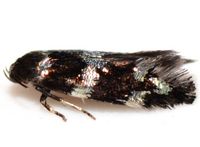Identification
Field Guide Descriptions: Online Resources: MPG , BugGuide , iNaturalist , Google , BAMONA , GBIF , BOLD , iNat Search Technical Description, Adults: Braun (1948, p. 84)Technical Description, Immature Stages: Braun (1948, p. 84)
Adult Markings: This is a minute blackish moth with white-tipped antennae, two silvery bands on its forewings, a pair of subterminal spots, and a centrally placed terminal spot. The following detailed description is based on the description by Braun (1948). The head is dark silvery gray, the lower part of the face paler, and the posterior margin of the head dark shining brown. The palp is nearly straight, dark gray, paler above, and concolorous with the face. The antenna is dark brown, with the apical fifth yellowish white. The thorax is dark brown in the anterior half, and dark bluish metallic in the posterior half. The forewing is dark brown with faint golden reflections. The base of the wing is silvery gray, with bluish reflections on the costa, and golden reflections toward the dorsum. Before the middle there is a slightly oblique metallic band that is silvery or pale golden. It often extends along the wing below the fold. Sometimes this extension is represented by a small detached silvery or golden dot. At two-thirds the wing length, there is a silvery or pale golden costal spot with a similar opposing spot on the dorsal margin. Beyond these there is a silvery spot in the middle of the wing near the apex. The cilia are grayish brown and paler around the apex. The apical row of scales is black-tipped and forms a sharply contrasting line. The hindwing is grayish brown and the cilia somewhat darker, especially in the female. The wing is broader in the male. The legs are dark silvery gray to blackish. The hind tibia is mostly silvery in the male and brown, except at apex, in the female. The abdomen is dark brown with some metallic luster above, and yellowish white beneath. Elachista madarella is similar to E. enitescens and E. argentosa . The latter two lack the white antenna tip and have not been found south of Ohio. Both are rare and only known from extreme southern Ohio and perhaps Maine.
Wingspan: 8-9 mm (Braun, 1948)
Adult Structural Features: Male and female reproductive structures are distinctive and are described and illustrated by Braun (1948).
Adult ID Requirements: Identifiable from photos showing hindwings, abdomen, or other specialized views [e.g., frons, palps, antennae, undersides].
Immatures and Development: Braun (1921, 1948) studied populations in Ohio where the larvae mine the leaves of Carex and Scirpus species. Larvae that mine in the autumn overwinter in the leaves and resume mining in the spring. The larva mines down the old overwintering leaf and then enters the leaf sheath of one of the new inner basal leaves. It then works upward toward the tip of the leaf. It feeds only at night and moves back into the leaf sheath near the root-stalk during the day. A single larva may mine more than one leaf. The larva is whitish or pale green, and the prothoracic shield has a pair of conspicuous L-shaped dark marks. Pupation often takes place on the upper side of a leaf over the midrib. The cocoon is a flat sheet of silk formed of two series of obliquely placed parallel threads crossing one another at an acute angle. Braun (1948) has details concerning the pupal morphology.
Larvae ID Requirements: Identifiable only through rearing to adulthood.

 »
»




 »
»


